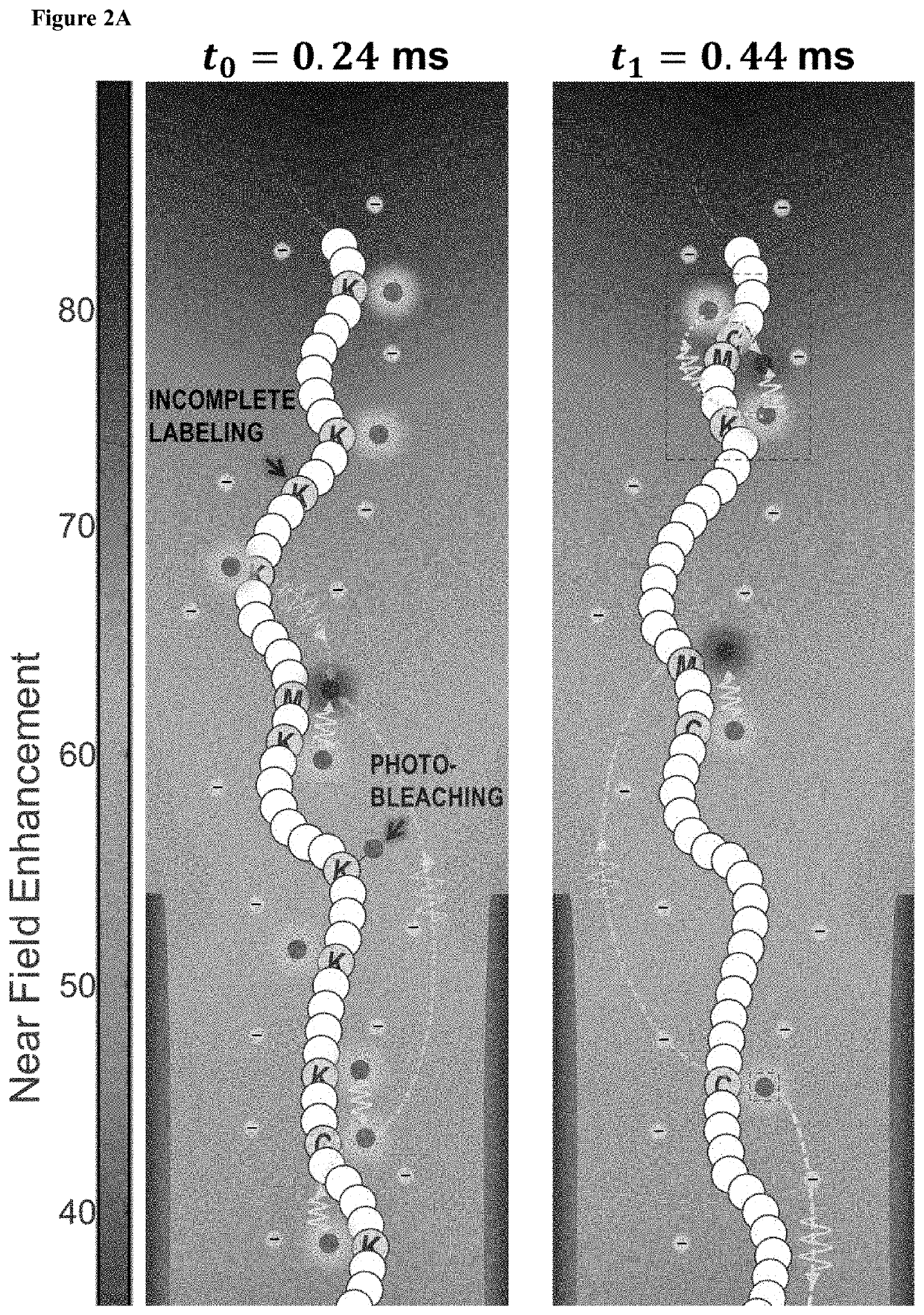Machine learning for protein identification
a technology of machine learning and protein identification, applied in the field of machine learning and nanopore-based protein sequencing, can solve the problems of global unmet challenges, extending these methods to routine proteome analysis, and specifically to single-cell proteomics, and the total number of proteins in each cell is staggering, and the resolution of single-molecule protein sequencing techniques such as mass spectrometry
- Summary
- Abstract
- Description
- Claims
- Application Information
AI Technical Summary
Benefits of technology
Problems solved by technology
Method used
Image
Examples
example 1
n of Nanopore-Based Recognition of Proteins
[0167]In the method of the invention, proteins extracted from any source (serum, tissue or cells), are denatured using urea and SDS (FIG. 1A). Three amino-acids lysine (K), cysteine (C) and methionine (M) are labeled with three different fluorophores using three orthogonal chemistries: the primary-amines in lysines are targeted with NHS esters; thiols in cysteines are targeted with maleimide groups, and methionines are labeled using the two-step redox-activated chemical tagging. The negatively charged SDS-denatured polypeptides are electrophoretically threaded, one at the time, through a sub-5 nanometer pore fabricated in a thin insulating membrane to ensure single file threading of the SDS-coated polypeptide. The voltage, nanopore diameter and other factors, such as solution viscosity are used to regulate the protein translocations speed. The nanopore is illuminated using laser beams for multi-color excitation. The excitation volume (FIG. ...
example 2
teome Protein ID Using Deep-Learning Classification
[0175]Next the simulations were vastly scaled-up to include thousands of different proteins, each one repeated hundreds of times under different labeling efficiencies, translocation velocities and spatial resolutions. The accurate classification of noisy, low-resolution, time-dependent signals is often encountered in areas such as image and speech recognition and is effectively handled by Convolutional Neural Networks (CNN) approaches. It was postulated that, provided sufficient training, the CNN approach would be able to identify most proteins based on the tri-color fingerprints. To check this hypothesis, deep-learning whole-proteome analyses were set up. First, the CNN network was trained using a large dataset containing at least 80 individual nanopore passages of each protein in the Swiss-Prot database. Then the CNN was presented with new protein translocation events and queried as to the protein identity. This procedure was repe...
example 3
ation of Plasma Proteome and Cytokines Panels
[0178]The performance of this approach for clinically relevant applications, including whole human plasma proteome and a cytokine panel, was evaluated. In both studies, the CNN training was kept at the whole human proteome, rather than restricting it to the clinical subset. Next, nanopore translocation traces of the plasma / cytokines proteins were presented and the classification accuracy was evaluated as before. Interestingly for the high-spatial resolutions (20 nm and 30 nm) the correct ID of the 3852 plasma proteins was only slightly larger than the whole proteome accuracy at the different labelling efficiencies, reflecting the fact that there is a small set of proteins that are hard to be classified in both cases (FIG. 6A-B, right panels). However, at the lower resolutions, especially for the 100 nm case in which there was observed a significant drop in the ID accuracy for the whole proteome results, very high scores for the plasma pro...
PUM
 Login to View More
Login to View More Abstract
Description
Claims
Application Information
 Login to View More
Login to View More - R&D
- Intellectual Property
- Life Sciences
- Materials
- Tech Scout
- Unparalleled Data Quality
- Higher Quality Content
- 60% Fewer Hallucinations
Browse by: Latest US Patents, China's latest patents, Technical Efficacy Thesaurus, Application Domain, Technology Topic, Popular Technical Reports.
© 2025 PatSnap. All rights reserved.Legal|Privacy policy|Modern Slavery Act Transparency Statement|Sitemap|About US| Contact US: help@patsnap.com



